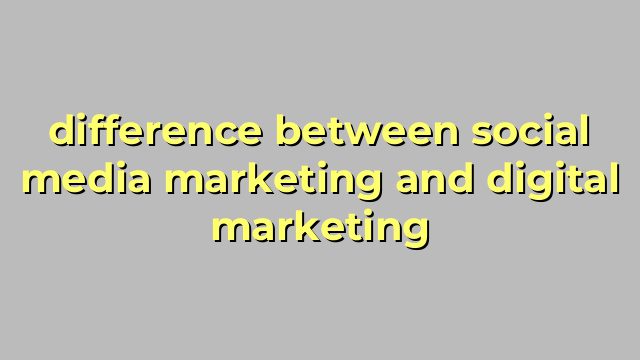Difference Between Social Media Marketing and Digital Marketing
Introduction
With the rise of digital media, brands and businesses are leveraging various digital marketing techniques to reach their target audience. Social Media Marketing (SMM) and Digital Marketing (DM) are two of the most popular techniques that businesses use to promote their products and services. While both terms may seem similar, they have different meanings, strategies, and techniques. In this article, we will explore the difference between SMM and DM.
Social Media Marketing (SMM)
Social Media Marketing is a subcategory of Digital Marketing that involves using social media platforms like Facebook, Instagram, Twitter, and LinkedIn to promote products or services. The primary goal of SMM is to increase brand awareness, engage with customers, and create a loyal following. SMM can involve paid advertising like Facebook Ads or organic content like posts, stories, and videos.
Digital Marketing (DM)
Digital Marketing is a broad term that encompasses all forms of marketing that use digital channels to reach customers. Apart from Social Media Marketing, Digital Marketing includes SEO, PPC, Email Marketing, Content Marketing, Affiliate Marketing, and Mobile Marketing. The goal of DM is to generate leads and sales, increase brand visibility, and build relationships with customers. DM involves creating a website, designing landing pages, creating email campaigns, and using analytics to track results.
Differences Between SMM and DM
1. Goals: The primary objective of SMM is to create brand awareness and engage with customers, while the main goal of DM is to generate leads and sales by converting prospects into customers.
2. Channels: SMM uses social media platforms like Facebook, Instagram, and Twitter, while DM includes a range of digital channels like SEO, PPC, Email, and Mobile Marketing.
3. Techniques: SMM involves creating organic and paid content for social media platforms, while DM involves designing websites, creating email campaigns, and using analytics to track performance.
4. Cost: SMM can be less expensive than DM as it involves organic content and paid advertising on social media platforms. DM may involve higher costs for website designing, email campaigns, and paid advertising on search engines.
Conclusion
Both Social Media Marketing and Digital Marketing are crucial for businesses to succeed in today’s digital age. While SMM focuses on building brand awareness and customer engagement, DM aims to generate leads and sales. Depending on the business objective, companies can choose the appropriate marketing technique to achieve their goals. SMM and DM require continuous analysis, optimization, and monitoring to drive results and remain relevant in the ever-changing digital marketing landscape.
Table difference between social media marketing and digital marketing
Here is a possible HTML table to compare social media marketing and digital marketing:
| Feature | Social media marketing | Digital marketing |
|---|---|---|
| Definition | Promotion of products or services on social media platforms | Promotion of products or services using digital channels such as search engines, email, mobile apps, or websites |
| Scope | Focuses on attracting, engaging and converting social media users | Covers a broader range of digital channels and strategies |
| Target audience | Primarily reaches social media users who may or may not be interested in the brand | Can target specific audiences through data analysis and segmentation |
| Content format | Often relies on visual and interactive content such as images, videos, polls, and stories | Can use a variety of formats such as text, images, videos, podcasts, webinars, e-books, etc. |
| Metrics | Emphasizes metrics such as engagement, reach, followers, and shares | Tracks a wider range of metrics such as leads, conversions, ROI, bounce rate, CTR, etc. |
| Advantages | Cost-effective, allows for quick feedback and interaction, can create viral content, builds brand awareness and loyalty | Offers more targeting options, measurability, scalability, flexibility, and can integrate with other marketing channels |
| Disadvantages | Can be time-consuming, difficult to measure ROI, limited control over algorithm changes and platform policies, risk of negative feedback and social media crises | Can be more expensive, complex, and require technical skills or external agencies, may encounter ad-blocking, privacy concerns, or compliance regulations |
